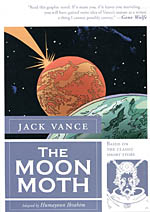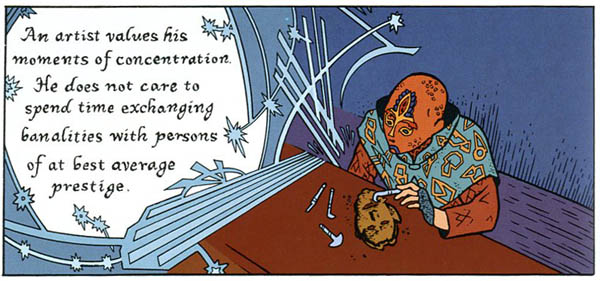 Original short story by Jack Vance
Original short story by Jack Vance
Adapted by Humayoun Ibrahim
128 pages, color
Published by First Second Books
Jack Vance is one of those authors who’s been successful in multiple genres (science-fiction, mystery, fantasy, autobiography) and doesn’t get half of the attention he deserves. With so much material published (there’s a 45-volume "integral edition" of his works out there, by way of example) it’s easy to have not read even a fraction of Vance’s writings, so hopefully The Moon Moth will help introduce a new audience to this author’s works. The original novella that The Moon Moth adapts was published half a century ago, but it says a lot about both Vance and adaptor Humayoun Ibrahim that it still feels fresh and original even now.
Ibrahim quickly introduces us to the main character of Edwer Thissell, a human on the planet Sirene. A consular representative, Thissell is in way over his head on Sirene. Everyone there wears masks that help determine rank and social standing, and you sing rather than speak to one another, accompanied on one of a dozen different musical instruments, each of which has a specific purpose and social situation. It’s a confusing-at-best society, one that Thissell’s floundering in. Then, add a murderer that Thissell has to track down, but could be anyone thanks to the masks that are always worn, and things are rapidly shifting from bad to worse.
Having never read the original short story before, I found myself pleasantly surprised with how well The Moon Moth read as a graphic novel. So often the transition from prose to sequential art feels like you’re only getting half of a story, but Ibrahim has a deft hand in not making the reader feel lost. Ibrahim makes a lot of good decisions early on in his adaptation; the first thing we get, for example, is a two-page spread detailing eleven different instruments, giving their names and for many their social purpose. Because music is such an important part of The Moon Moth, this key early on helps guide us through what could otherwise be confusing. Ibrahim also assigns each instrument a specific visual for word balloons for the accompanying singing. It’s a clever way to bring something across to the reader in a visual manner that could have easily been clunky. You instantly understand when someone’s singing versus talking, and the shifting from one instrument to the next can be done without having to have characters hold up instruments or draw attention to them when the visual should be focusing on something else. And of course, The Moon Moth‘s usage of masks comes across effortlessly in a visual format; it’s the obvious easy transition from prose to illustration, but Ibrahim doesn’t take it for granted, designing each mask to look as extravagant or humble as the societal position that it’s supposed to designate.

The story itself in The Moon Moth is clever, telling a murder mystery on a world where everyone is in disguise. Vance and Ibrahim bring across the hopeless nature of Thissell’s task quickly, and watching him fumble through the process is entertaining in part because most of the roadblocks are ones created by Thissell himself. The resolution of how Thissell finds the murderer is a little underwhelming, but I think that’s because the interesting part is not in how Thissell finds the killer, but rather what happens next. The Moon Moth wraps everything up in such a satisfying manner—one that is foreshadowed yet still took me by surprise—that it was hard to keep from clapping with glee as it all fit together perfectly.
Ibrahim’s art in general is good, moving from one scene to the next in a careful manner. I like the clothing and masks that Ibrahim drapes the world of Sirene in, and as mentioned before, the word balloon borders are truly inspired. As much as I love the balloon borders, though, I do wish that someone else had done the actual lettering within them. The letters sometimes look a bit fuzzy and weak, and it occasionally distracts from all of the care that Ibrahim put in throughout the book. Still, it’s a minor flaw in an otherwise impressive adaptation.
Carlo Rotella from Boston College writes an introduction to The Moon Moth explaining the significance and stature of Vance, but after reading The Moon Moth I feel like readers will understand already that Vance is an excellent writer. This is a great introduction to Vance’s writing, and it’s making me want to deviate off of my planned reading list to explore some of Vance’s other works that I’ve yet to get around to. The Moon Moth might be Ibrahim’s first graphic novel, but I hope it’s not his last; he showed great skill in adapting Vance’s story, and I’m curious to see what he’ll do next.
Purchase Links: Amazon.com | Powell’s Books
